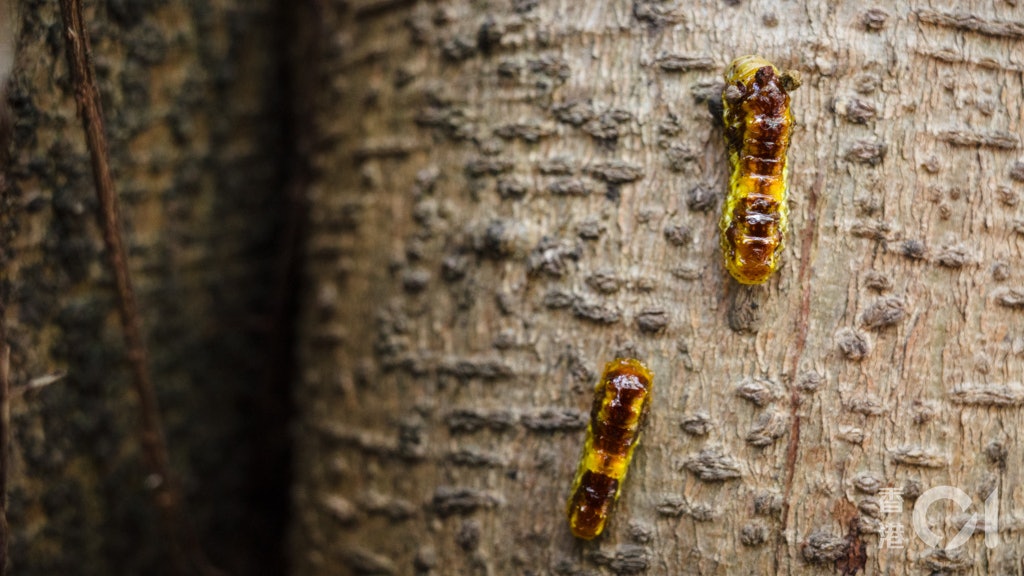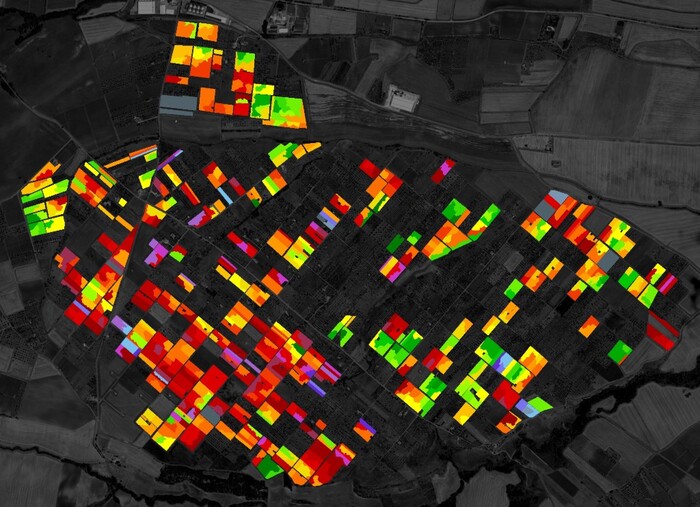In recent months, the vermillion moth has been "being strange" again. Whether it is on the side of the road, on the street or in the park, the banyan trees in many districts suddenly "bald", and the withered "landscape" of the canopy reappears, and there are signs of spreading.
Retired arborist Yuan Dacheng observed the insect situation "closely patrol" and found that the second wave of ficus moth disasters this year has almost covered the entire New Territories. At the same time, the moth plague has also reached parts of Kowloon, including Tai Kok Tsui and Hung Hom. Bay.
The newly-increased hardest hit area is Tsuen Wan, and a quarter of the area has been "lost" in the moth disaster.
The Development Bureau replied that the total number of moth-affected banyan trees in Hong Kong last month was about 2,500. Among them, the number of old and famous trees that were eroded increased to 27. Yuen Long District continued to be the worst-hit area in Hong Kong.
▼Larva of Vermillion Moth ▼
Ficus moth disasters broke out sporadically in individual areas in Yuen Long, Tin Shui Wai, and Tuen Mun. However, at the end of last year, the pests have formed a "biological pathway", spreading from the original "territory" to the North District, affecting many ancient and famous trees, and some ancient trees. The tree has suffered from brown root disease, forming a double pincer.
The warm and dry weather also caused the first wave of moth plagues to erupt earlier this year.
Tai Po and Tsuen Wan "lost" in the moth plague
Yuan Dacheng, who has been following the vermillion moth, visited many districts in recent months and found that this year's second wave of outbreaks further affected Tai Po and Chinese University in the East of the New Territories, and Tsuen Wan and Kwai Chung in the West of the New Territories.
The moths even rushed out of Kowloon. In Tai Kok Tsui and Hung Hom Bay, larvae of Vermillion Moth were also found, but the condition was relatively mild. The baldness of the trees ranged from mild to 20%, and no adults were seen for the time being.
Yuan said that some of the affected banyan trees are located in private properties and can only be dealt with by persuading the property management company.
He worries that if the prevention and control work is insufficient, it will not be guaranteed to spread to West Kowloon, and that it will further spread to the ancient forested Parkside Avenue in Tsim Sha Tsui next year.
Yuan Dacheng said that the previous wave of epidemics in Tai Po and Tsuen Wan was considered "preventable and controllable", but the new wave of banyan moth plagues have affected most of the Tai Po District, as well as Ting Kok Road and Tai Mei Tuk; The disaster in Tsuen Wan also moved south from Sham Tseng, affecting Ting Kau, Lido Bay and other places. The City Hall and Tsuen Wan Park also broke out slightly. It was described that a quarter of Tsuen Wan had been "lost" and became a new hardest hit area.
He analyzed that due to the large number of hosts, the strong insect reproduction ability, the warm and dry climate, the lack of natural enemies, and the inadequate greening management, insect pests continue to "divide households" to various places and raging in the occupied areas.
In order to prevent and control the vermillion moth, the government department used bamboo, straw mat or linen cloth to wrap the trunk to catch the larvae that moved on the trunk.
Yuan has previously described that the objects are not "spiritual banners", and the pests will not die after contact. If there is no supervision of the contractor’s work situation or clear guidelines, the parcels should be cleaned up frequently and hidden in tree trunks or roots. Larvae, reduce the base of the insect population, and it is impossible to prevent and control insect pests.
27 ancient and famous trees affected by moth plague
According to the information provided by the Development Bureau, as of last month, the number of banyan trees affected by moths reached 2,555. The total number and geographical distribution are roughly the same as in June. Among them, Yuen Long District accounts for nearly 70%; followed by North District and Tsuen Wan District with 22 trees. Increased to 71 trees.
Among the affected banyan trees, there are 27 ancient and famous trees, which are 4 more than when the media enquiry was answered in June. They are located in Tai Po, Tuen Mun and North District. The old and famous banyan trees at Park Avenue, Tsim Sha Tsui were not affected. .
A spokesman for the Development Bureau pointed out that the tree management department tried new pest control technologies, including soil injection and tree trunk injection, to soak the insecticide into the leaves and kill the larvae that eat the leaves. The department is closely monitoring its effectiveness.
Arborist's recommendations for the prevention and control of ficus moth disasters:
1. Strengthen pest monitoring
Monitor throughout the year, especially the harmful period of adult and larvae from March to November.
2. Adopt comprehensive prevention and control measures
In terms of physical prevention and control, according to the characteristics of newly emerging adults, such as weak flying ability, often inhabiting low shrubs and plants, and bright colors and easy to find, in the early stage of emergence peak, manual capture methods are used to reduce the base of the insect population; for larvae there are up and down The trunk is used to use the "straw mat/straw entanglement method" to manually collect and destroy the larvae.
In terms of chemical control, the larvae will be controlled once at the initial incubation period and at the 3rd to 4th instar. It is predicted that April to May, July to August and October to November this year will be important time for the control of Vermillion Moth larvae. Apply a systemic pesticide under the tree, and then transport it to the crown leaves after being absorbed by the roots, allowing the newly hatched larvae to gnaw on the leaves and die.
3. Do a good job in management and prevention and control measures
Overwintering or oversummering pupae should be thoroughly cleaned and concentrated, and different green prevention and control measures should be taken for different habitats (such as parks, roadside green spaces, housing estates, schools, wetland reserves, rural areas, etc.) to benefit the ecological environment And protect species diversity.
Choosing to use pesticides is the last and urgent need. The goal is to restore the ecological balance of urban gardens, where trees and insects go hand in hand.
Affected by the distribution of banyan moths.
(Provided by interviewee)
▼In May this year, the first wave of vermillion moths broke out in many districts in the New Territories ▼
+12
Banyan moth plague|Changchun Club first saw vermilion hairy spotted moths on the bottom of a banyan tree bitten in urban areas | Four old trees suffering from "tree cancer" were attacked by insect pests Banyan moth plagues | Trunk mats, burlap bags, insect catching experts urged to clear the pupae to prevent banyan moths from breaking down | Vermillion moths broke out again in the New Territories banyan trees were attacked and bald, and 23 ancient trees were affected
01News








/cloudfront-eu-central-1.images.arcpublishing.com/prisa/2C5HI6YHNFHDLJSBNWHOIAS2AE.jpeg)



